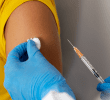
SELF-SUFFICIENCY. Isidro Albano, the Dairy Industry Confederation of the Philippines Chairman and Mindanao Alliance of Dairy Industry Stakeholders Association (MADIS) President, says the dairy industry in the country is eyeing to increase the self-sufficiency rate from one percent to 10 percent in a period of five years. (Robby Joy D. Salveron/davaotoday.com)
DAVAO CITY, Philippines – With the country’s production comprising only one percent of the national dairy requirement, the dairy industry embarks on another attempt to increase it to 10 percent after five years, an official said.
“Right now the challenge actually for the dairy industry is to produce 99 percent more to be self-sufficient on our dairy requirements. For the longest time, Filipino local producers produces only one percent of the total demand,” said Isidro Albano, head of both the Dairy Industry Confederation of the Philippines and Mindanao Alliance of Dairy Industry Stakeholders Association (MADIS), said in a press conference on Monday, July 31.
Albano added that currently majority of the dairy products come from New Zealand.
Albano said that in terms of liquid milk, the country only produces one glass out of every three glasses or only one third is being provided. Moreover, 64 percent of liquid milk comes from the cow, while 33 percent are from Carabao and three percent are sourced from goats.
Albano pointed that with the given roadmap for the next five years, Department of Agriculture Secretary Emmanuel Piňol challenged them to increase the sufficiency rate of dairies.
“The strategies or the roadmap for this five year program of the Department of Agriculture under Secretary Piňol was presented to him last week. He gave us the go signal, he already gave his commitment to support the dairy industry through this five year program challenge that he gave us,” Albano said.
One of the schemes in the roadmap to increase and attain higher level of milk sufficiency in the country is the herd build-up.
Albano said apart from the existing ‘embryo transfer’ strategy, DA is also considering to import a new breed of cattle from Brazil called “Girolando,” a breed known primarily for milk-production and can also be used for beef production.
“The DA considering a new breed which is a Girolando that will be coming from Brazil but still quarantine protocol has to be discussed with other stakeholders or other industries that might be in consideration with these steps,” Albano said.
Apart from it, Albano mentioned they are also encouraging “backyard farmers to produce more milk through good nutrition and proper health care for animals.”
In support to the industry’s roadmap, Business Development Consultant, Marco Suarez of the Obu Manuvu Ancestral Domain Tribal Council of Elders/Leaders Inc. said the grassland or roughage to feed the cattle should be put into consideration.
“We are embarking on a massive planting of high-yielding grass for roughage for cattle. With this roadmap we also have to consider the roughage or the grass that comes with it and it can only happen if we have the hectarage,” Suarez said.
Suarez said they’ve negotiated with the Obu Manuvu tribe in Marilog to utilize about 36,000 hectares of land in Baguio and Marilog district here for roughage.
Albano said the city has about a thousand cattles of which mostly belongs to backyard farmers while some are in dairy multiplier farms.
“It’s been always a problem to most of dairy farmers iyong pagkain ng baka. So with the help of the group of Obu Manuvu through the assistance of Marco I think mas madali nating mapalambo ang industriya,” Albano said.
Albano said they are optimistic that if all things in the roadmap will be implemented, the self-sufficiency rate of dairies in the Philippines can even go beyond 10 percent after the said period.(davaotoday.com)








